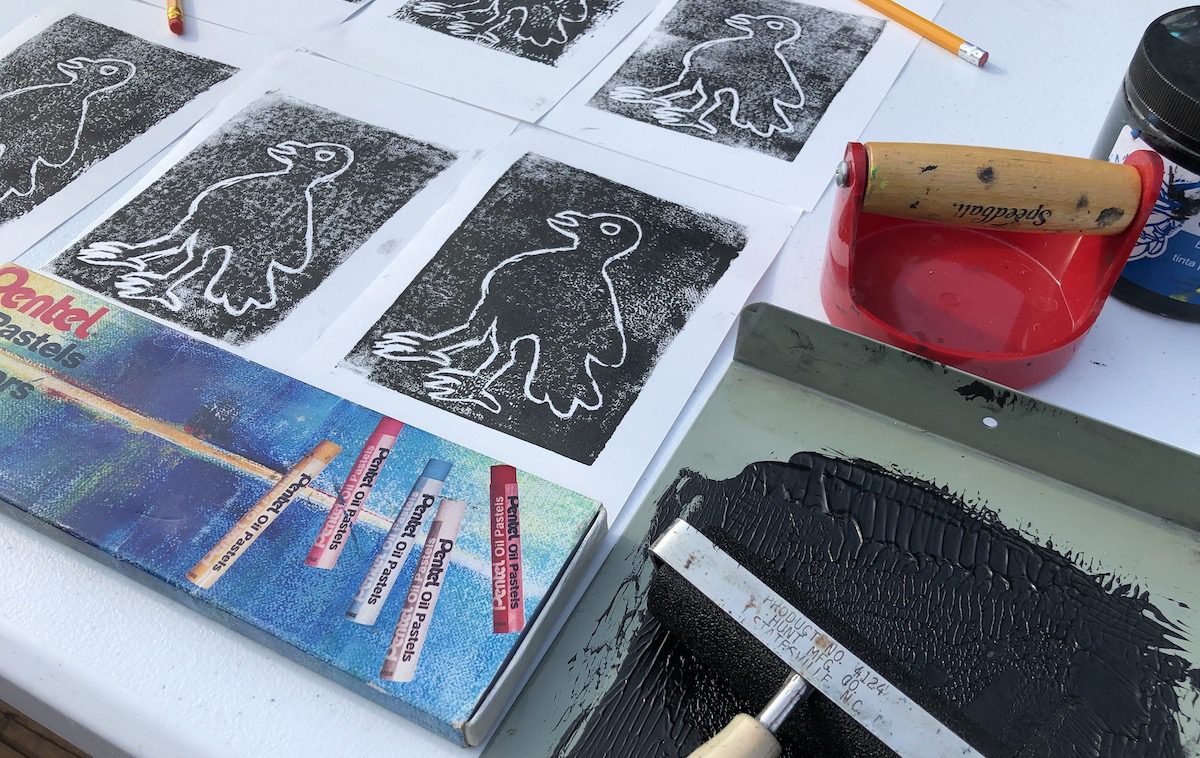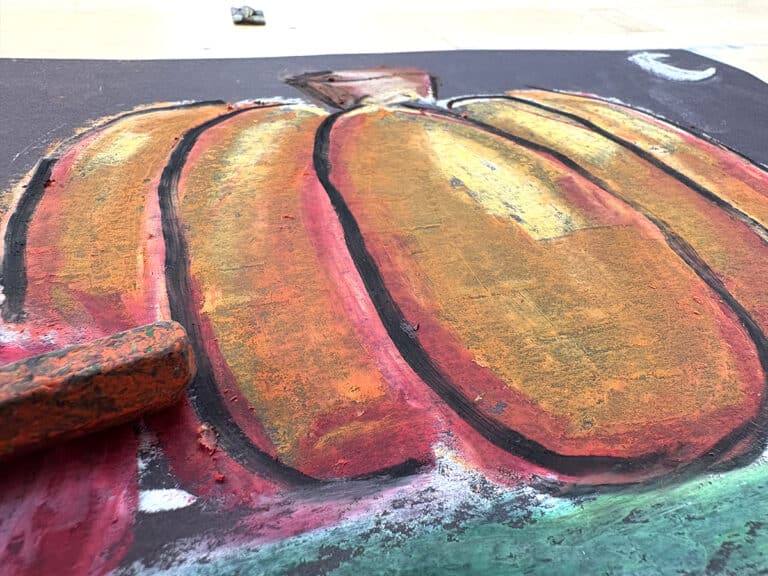One way to engage students in printmaking is to challenge what they may already believe. In his book, Beautiful Blackbird, author, Ashley Bryan, does just this.
Beautiful Blackbird Prints Inspired by Ashley Bryan
Written and illustrated by Ashley Bryan, Beautiful Blackbird is a children’s story that celebrates the message, “Black is beautiful.” The birds in the forest were bright colors of red, yellow, green, and blue, all except Blackbird. Blackbird was voted the most beautiful bird in the forest. The other birds were incredibly jealous of Blackbird’s beauty. They begged Blackbird to paint their feathers black so they could be beautiful, too.

Blackbird agrees to paint the birds’ feathers but explains that how they look on the outside doesn’t change what’s on the inside. Each bird is unique, and regardless of how they look on the outside, it doesn’t change how they act. Blackbird says, “Color on the outside is not what’s on the inside. You don’t act like me. You don’t eat like me. You don’t get down in the groove and move your feet like me.”
Author and Illustrator, Ashley Bryan
Ashley Bryan was born in Harlem, New York City, in 1923. He loved drawing and painting as a child. He created his first book in kindergarten as the author and illustrator of his own alphabet book! He continued to develop his artistic skills and had a strong portfolio when it came time to apply to art school. Bryan faced discrimination, and many of his applications were denied because of the color of his skin. Eventually, in 1938, Bryan was accepted to Cooper Union School of Art and Engineering in New York City.
Bryan served as a soldier in the segregated United States Army during WWII. He hid art materials in his gas mask so he could sketch everything he experienced. After the war, Bryan continued to work as an artist and teacher. He traveled to France, where he listened and sketched musicians. Music and rhythm would influence his artistic style from this time on.
Explore more artists: 17 Black Artists to Know (Ep. 222)
Bryan continued to travel and study art around the world. He taught at over ten different institutions, always finding a way to incorporate music and poetry with art. In 1962, Bryan illustrated Moon, for What Do You Wait?, a collection of poems by Rabindranath Tagore. Editor, Jean Karl, was impressed by Bryan’s style that was inspired by different cultures. Karl and Bryan would go on to work together for nearly four decades.
After illustrating many books that brought African tales and proverbs to life, Bryan began work on Beautiful Blackbird in 2001. The story is based on a Zambian tale. Bryan used his mother’s sewing scissors to cut the figures of birds from colorful craft paper. Beautiful Blackbird became one of Bryan’s most successful books and earned a Coretta Scott King Book Award in 2004.
Themes and Lessons to Share with Students
The overall message of Beautiful Blackbird is that black is beautiful. This is a great book to include in your art room, as many children’s books and animations use the color black to communicate something scary or evil. If you look at popular animated villains, the character is often dark in color. Bryan challenges color archetypes with the main character, Blackbird, celebrated as the most beautiful in the forest.
Blackbird reminds the other birds, “Color on the outside is not what’s on the inside.” This message that one’s inner self, character, and how they treat others is more important than external appearances resonates today. Students can reflect and compare how they present themselves on the outside to how they think and feel on the inside.
Printmaking Lesson
Bryan illustrated Beautiful Blackbird using cut-paper collage. You could certainly have your students create their own collages inspired by this wonderful children’s book. You could also apply the characters and spirit of the story to a fun and easy printmaking lesson emphasizing and celebrating the message, ‘Black is beautiful.’

Many printmakers would agree, there is nothing more beautiful than a freshly pulled print with black ink. The contrast against the white paper makes for a powerful image. Your students can discover the joys of printmaking with a simple introduction to relief prints.
For more: 10 Everyday Items to Help Manage the Mess of Printmaking
The trickiest part for students is often the reversal of positive and negative space. While they may be used to drawing a dark pencil line on white paper, the opposite will be true of their print. The line will be white, and the negative space will be black ink. No amount of explaining or demonstrating has the impact of students experimenting and pulling their first print. The concept will click as they have hands-on practice.
Using Scratch Foam Board
If your students are experienced with printmaking, then linoleum or E-Z -Cut blocks will make some wonderful prints. However, if you’re just introducing printmaking, or working with younger students, you may consider trying scratch-foam board. This is relatively inexpensive and can easily be cut down to smaller pieces. If you’re on a tight budget, you can also experiment with Styrofoam trays from your cafeteria or local grocery store.

Have students sketch a bird figure on paper first. Have them sketch bigger or smaller than the piece of scratch foam you intend to give them. If their sketch is the same size, many students will be tempted to try and trace or transfer their design to the foam. While this can be successful, it can also lead to problems with alignment and unwanted permanent marks on the foam.
Treat the paper sketch as a rough draft, and then students will be ready to draw their design directly on the foam. Explain and demonstrate how much pressure is needed to create a clear mark on the foam. Students can use a regular pencil or a sharpened wooden stick, like toothpicks or a ceramic tool. They will draw their design into the foam without pushing all the way through. Once their design is complete, they’re ready to print!
Creating an Edition
The beauty of printmaking is the ability to make multiple prints. However, paper and materials can be a limited resource in your art room. Require a small number of prints students need to make to create an edition.

It would be great if each student could make one for every student in the class, but you would quickly run out of paper, ink, and patience if that were the case. Instead, ask students to make enough to trade with their table group, and keep one for themselves.
Experimenting with Altered Prints
Once your students have successfully pulled a small edition of their prints using black ink, they can create emphasis by applying bright colors around the bird figure. Oil pastels work great on top of dried printing ink. Students can create a colorful background to make their bird stand out as the most beautiful in the forest. You can point out motifs used in Bryan’s illustrations of plants, flowers, and trees. Students could include some of the other colorful birds in the background as well. By adding lots of color around the figure, the blackbird comes to life. This is a great example of using the element of emphasis in a work of art.

Because students have an edition to work with, each print is a new opportunity to experiment with different colors and designs to alter the background. The central figure is the same in each print, but how the student chooses to alter each background can be different.
Collaborative Display
Before students exchange their prints, display their creations for your school and community to see! The project is inspired by an award-winning children’s book, so you may consider reaching out to your school or public libraries about creating a display in their space.
If you teach multiple grade levels, you may expand this subject matter to different projects. Younger elementary students could cut and decorate their own paper birds. Older students could create altered prints, and you may have advanced students who could write and illustrate their own poems inspired by Bryan’s work. This would make for an exciting collaborative display in your community.
Final Thoughts
Ashley Bryan’s stunning illustrations and story have universal themes for students of any age. As art educators, we want our classroom to be a place of community, respect, and appreciation for all students. Bryan’s work shows us that black is beautiful. This is a much-needed message in children’s literature, as well as the art room.
Printmaking is a fun and magical activity for students to discover and experiment with. Altered prints give them a bit more freedom to take chances and play with color and design. Enjoy the process along with them. Celebrate the differences in their prints. They may all be creating the same subject, but each print is as unique as they are.
What projects have you taught inspired by children’s books?
How do you approach printmaking with younger students?
What are your favorite tips to make printmaking easier in the art room?
Magazine articles and podcasts are opinions of professional education contributors and do not necessarily represent the position of the Art of Education University (AOEU) or its academic offerings. Contributors use terms in the way they are most often talked about in the scope of their educational experiences.






